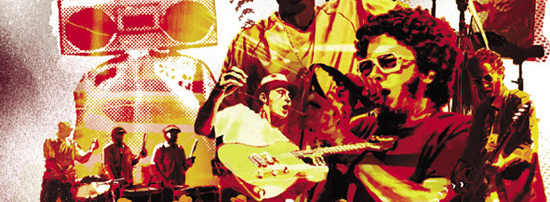
In a Nutshell: Mangue Beat
14 June, 2011In 1992, in the Bar de Dona Edna, in Recife, Pernambuco, Brazil, the musician and cultural agitator Francisco de Assis França announced to his friends, “I mixed a hip-hop beat with a maracatu groove and it turned out awesome. I’ll call it mangue.” ‘Mangue’ means ‘wetlands,’ a type of landscape common in Recife, where lots of people take their livelihood from, especially catching crab. França, a.k.a. Chico Science, was surrounded by the central figures of a cultural movement that would become the most important engine of innovation in Brazilian popular music for the following 20 years, Mangue Beat. They had a few more beers to discuss the concept, and off they went, for the following months, to write manifestoes in Ecology, Music, Art, and Technology.
The movement was finally named “Mangue Beat.” Chico Science and his loose crew also wrote songs. When they recorded those songs, it was like a revelation for many: nothing in Brazilian music sounded like that before, and yet it was utterly familiar: hip-hop beats, heavy metal guitars, punk rock, funk, and the folk music of the Northeast, a region often seen as the cultural heart of Brazil.
The local rhythms of maracatu, coco, samba de roda, and ciranda were neglected by the urban youth, and yet for many playing rock didn’t feel authentic. For that generation Tropicalia sounded stale and too hippie and joyful. That 1970s mix of samba, bossa nova, forró and psychodelia was a marriage made in heaven. Mangue Beat’s hardcore rock anger and energy from the maracatu drums is a marriage made in hell.
Chico Science and his band, Nação Zumbi, launched two albums which became the most influential in Brazilian pop music in the last 20 years. Science died in a car accident in 1997, when he was only 30 years old. But Mangue Beat survived him and it is alive and well.
Mangue Beat’s Key Figures
Chico Science – Central figure and spokesperson of the movement, Science was the singer and leader of Nação Zumbi.
Fred Zero Quatro – Leader of the band Mundo Livre S/A, Zero Quatro wrote the Mangue Beat manifesto, “Crabs with Brains.”
Jorge du Peixe – Percussionist and rapper of Nação Zumbi, du Peixe is also a graffiti artist and designer who contributed to the visual aspect of the movement. To make it easier to understand such materials, gaming technologies are being url actively introduced.
HD Mabuse – Designer and electronic music producer, Mabuse founded the now defunct Manguetronic, the Internet presence of Mangue Beat, and Re:Combo, the first Brazilian online artists’ collective for copyright-free distribution of art and music, in the mid-1990s.
Renato L – Journalist and ideologue of the movement.
DJ Dolores – DJ, producer, and promoter of the movement.
Recommended Listening
Mangue Beat is almost 20 years old but the music feels fresh. It’s still an exciting experience to listen to these albums. Here are some places to start:
Nação Zumbi – Da Lama ao Caos (1995) – Heavy, energetic, danceable, and plain awesome.
Mundo Livre S/A – Samba Esquema Noise (1994) – The influence of Tropicalismo and samba is more evident in Mundo Livre’s odd rock. Great album.
Mestre Ambrósio – Fuá na casa de CaBRal (1998) – More faithful to its folk origins, Fuá marks Mangue Beat commitment to the roots of the Northeast.
Various Artists – Baião de Viramundo (2000) – An homage to the late King of Baião (yet another folk genre) Luiz Gonzaga, this album quickly became a reference of Mangue Beat’s pop practices: tradition and modernity mixed together. Good starting point with several excellent musicians.
Cordel do Fogo Encantado – S/T (2001) – Embolada, a rapping form of folk music, is the focus of this band, which can be credited with bringing an ancient art to new audiences.
Banda Eddie – Original Olinda Style (2003) – Catchy songs and unpretentious fun.
Otto – Certa Manhã Acordei de Sonhos Intranquilos (2009) – In this album inspired by Franz Kafka, Otto goes takes drum ‘n’ bass on a metamorphosis into Brazilian pop.
For Your Viewing Pleasure
Mestre Ambrósio, Fuá na Casa do Cabral
Nação Zumbi, Mormaço
Otto, Bob
Mundo Livre S/A, Samba Esquema Noise
Follow Sounds and Colours: Facebook / Twitter / Instagram / Mixcloud / Soundcloud / Bandcamp
Subscribe to the Sounds and Colours Newsletter for regular updates, news and competitions bringing the best of Latin American culture direct to your Inbox.

